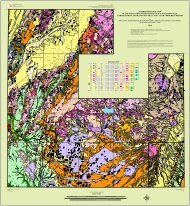Wetlands in northern Salt Lake Valley, Salt Lake County, Utah
Wetlands in northern Salt Lake Valley, Salt Lake County, Utah
Wetlands in northern Salt Lake Valley, Salt Lake County, Utah
Create successful ePaper yourself
Turn your PDF publications into a flip-book with our unique Google optimized e-Paper software.
WETLANDS IN NORTHERN SALT LAKE VALLEY, SALT LAKECOUNTY, UTAH—AN EVALUATION OF THREATS POSED BYGROUND-WATER DEVELOPMENT AND DROUGHTby Sandow M. Yidana, Mike Lowe, and Richard L. EmersonABSTRACT<strong>Salt</strong> <strong>Lake</strong> <strong>Valley</strong> is a largely urban area with a grow<strong>in</strong>g population.Most of the development <strong>in</strong> <strong>Salt</strong> <strong>Lake</strong> <strong>Valley</strong> usesmunicipal water sources, pr<strong>in</strong>cipally wells completed <strong>in</strong> thebas<strong>in</strong>-fill aquifer system. The population growth and concomitant<strong>in</strong>crease <strong>in</strong> municipal ground-water pump<strong>in</strong>g couldsignificantly decrease the amount of ground water dischargedfrom the pr<strong>in</strong>cipal aquifer system (where most wells are completed)to the shallow unconf<strong>in</strong>ed aquifer system.The shallow unconf<strong>in</strong>ed aquifer overlies conf<strong>in</strong><strong>in</strong>g beds abovethe pr<strong>in</strong>cipal aquifer system <strong>in</strong> the central and <strong>northern</strong> partsof the valley, and provides water to spr<strong>in</strong>gs and approximately58,000 acres (23,500 hm 2 ) of wetlands <strong>in</strong> ground-water dischargeareas. Decreased recharge to the shallow unconf<strong>in</strong>edaquifer from the pr<strong>in</strong>cipal aquifer due to <strong>in</strong>creased groundwaterpump<strong>in</strong>g could reduce water supply to these spr<strong>in</strong>gsand wetlands. Also, water supply to the spr<strong>in</strong>gs and wetlandsis affected by climatic conditions and Great <strong>Salt</strong> <strong>Lake</strong> level.Drought conditions dur<strong>in</strong>g 1999–2004 reduced the amount ofrecharge to ground-water aquifers across the state, <strong>in</strong>clud<strong>in</strong>gthe Great <strong>Salt</strong> <strong>Lake</strong> area, negatively impact<strong>in</strong>g the <strong>Salt</strong> <strong>Lake</strong><strong>Valley</strong> wetlands. In 2005 and 2008, the elevation of Great <strong>Salt</strong><strong>Lake</strong> decl<strong>in</strong>ed to near its historic lowstand reached <strong>in</strong> 1963,allow<strong>in</strong>g some parts of the <strong>Salt</strong> <strong>Lake</strong> <strong>Valley</strong> wetlands to dewater.To evaluate the potential impacts of drought and <strong>in</strong>creased developmenton the <strong>Salt</strong> <strong>Lake</strong> <strong>Valley</strong> wetlands, we used exist<strong>in</strong>gdata to estimate a water budget and develop regional, threedimensional,steady-state and transient MODFLOW modelsto evaluate water-budget changes for the wetland areas; theseefforts focused on wetlands around the marg<strong>in</strong>s of Great <strong>Salt</strong><strong>Lake</strong>, although the results may apply to all of the wetlands<strong>in</strong> <strong>Salt</strong> <strong>Lake</strong> <strong>Valley</strong>. The model<strong>in</strong>g suggests that subsurface<strong>in</strong>flow <strong>in</strong>to the wetland areas would be most affected by decreasedsubsurface <strong>in</strong>flow due to long-term (20-year) droughtconditions, which would also cause changes <strong>in</strong> Great <strong>Salt</strong><strong>Lake</strong> levels, but subsurface <strong>in</strong>flow would also decrease due to<strong>in</strong>creased municipal and <strong>in</strong>dustrial well withdrawals over thesame time period. Therefore, the worst-case scenario for thewetlands would be a comb<strong>in</strong>ation of both conditions. If theU.S. Environmental Protection Agency’s goal on no net lossof wetlands is to be met, the <strong>Salt</strong> <strong>Lake</strong> <strong>Valley</strong> wetland areasshould be managed to ma<strong>in</strong>ta<strong>in</strong> their current budget of water(estimated at about 52,420 acre-feet per year [65 hm 3 /yr] ofrecharge).We also <strong>in</strong>stalled shallow monitor<strong>in</strong>g wells <strong>in</strong> the <strong>Salt</strong> <strong>Lake</strong><strong>Valley</strong> wetland areas to determ<strong>in</strong>e hydraulic gradient andground-water quality <strong>in</strong> the shallow unconf<strong>in</strong>ed aquifer. Themagnitude and direction of the hydraulic gradient are similarto those documented previously, where ground water <strong>in</strong> thewetland areas flows north toward Great <strong>Salt</strong> <strong>Lake</strong>. Total-dissolved-solidsconcentrations for water samples collected fromtwo shallow monitor<strong>in</strong>g wells are 6786 and 21,324 mg/L.This model-dependent study <strong>in</strong>dicates that wetlands <strong>in</strong> <strong>Salt</strong><strong>Lake</strong> <strong>Valley</strong> may be stressed <strong>in</strong> the future. Drought and <strong>in</strong>creaseddevelopment due to population growth could dramaticallyreduce the amount of water the wetlands receive. Measuresto reduce the potential for degradation of the <strong>Salt</strong> <strong>Lake</strong><strong>Valley</strong> wetlands <strong>in</strong>clude development restrictions, re-use ofwastewater upgradient of the wetlands, and implementationof water conservation practices.INTRODUCTIONBackground<strong>Salt</strong> <strong>Lake</strong> <strong>Valley</strong> (figures 1 and 2), <strong>in</strong> <strong>Salt</strong> <strong>Lake</strong> <strong>County</strong>, <strong>Utah</strong>,is a largely urban area along the southern marg<strong>in</strong> of Great <strong>Salt</strong><strong>Lake</strong> that cont<strong>in</strong>ues to undergo population growth. Most ofthe development <strong>in</strong> <strong>Salt</strong> <strong>Lake</strong> <strong>Valley</strong> uses municipal watersources, pr<strong>in</strong>cipally wells completed <strong>in</strong> the bas<strong>in</strong>-fill aquifersystem. The population growth and concomitant <strong>in</strong>crease <strong>in</strong>ground-water usage for municipal supply (figure 3) could significantlydecrease the amount of ground water dischargedfrom the pr<strong>in</strong>cipal aquifer system (where most wells are completed)to the shallow unconf<strong>in</strong>ed aquifer system. The shallowunconf<strong>in</strong>ed aquifer overlies conf<strong>in</strong><strong>in</strong>g beds above the pr<strong>in</strong>cipalaquifer system <strong>in</strong> the central and <strong>northern</strong> parts of the valley,and provides water to spr<strong>in</strong>gs and approximately 58,000acres (23,500 hm 2 ) of wetlands <strong>in</strong> ground-water dischargeareas, which accounts for 98% of <strong>Salt</strong> <strong>Lake</strong> <strong>County</strong> wetlands.<strong>Salt</strong> <strong>Lake</strong> <strong>Valley</strong> has been closed to new water rights appropriationss<strong>in</strong>ce 2002, and between 1991 and 2002 only fixedtimewater appropriations were available to residents withspecial circumstances (<strong>Utah</strong> Division of Water Rights, 2008a,
















